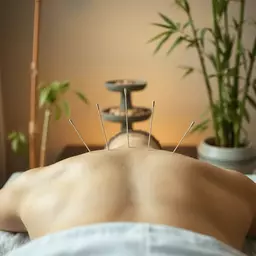Global Acupuncture Practices Explored

Posted on: 2025-05-27
By: Kaiya Whitmore
Have you ever wondered how a traditional healing practice can flourish and adapt across different cultures? As acupuncture spreads around the globe, it not only transforms individual wellness routines but also reveals the rich narratives that shape its practice in various societies.
What You Will Learn
- Global Accessibility: Acupuncture is increasingly accepted in various countries, demonstrating its integration into modern healthcare practices.
- Cultural Adaptations: Different cultures have tailored acupuncture techniques to fit their unique health philosophies and medical needs.
- Personalized Treatments: Practitioners can enhance treatment effectiveness by understanding and incorporating patients' cultural backgrounds into their care.
- Collaboration Among Practitioners: Sharing cultural insights can foster collaboration and improve acupuncture practices worldwide.
- Perception Impact: Cultural views significantly affect how acupuncture is perceived and can influence treatment outcomes.
- Research and Growth: An expanding body of research continues to explore acupuncture's efficacy in diverse healthcare contexts.
Cultural Variations in Acupuncture Practices
The diversity of acupuncture practices across different cultures highlights unique techniques and patient perspectives. Below are some key insights represented visually.
Accessibility of Acupuncture
Acupuncture has become widely accepted in many countries, integrating into various healthcare systems.
Cultural Adaptation of Techniques
Different cultures have tailored acupuncture to fit their healing practices, showcasing a blend of ancient and modern approaches.
Research Growth
There is increasing research into the efficacy of acupuncture across various healthcare environments, enhancing its applicability.
Cultural Perception of Efficacy
In Eastern cultures, acupuncture is viewed as holistic, while in Western contexts, it may be seen as a complementary therapy, affecting patient outcomes.
Understanding Cultural Variations in Acupuncture Practices
Acupuncture has traveled far beyond its origins in China, weaving itself into the fabric of healthcare across the globe. Today, it stands as a fascinating blend of ancient wisdom and modern application, impacting wellness routines in diverse cultures. Have you ever considered how a practice rooted in one tradition can adapt and flourish in another? This global relevance of acupuncture not only highlights its effectiveness but also reveals rich cultural narratives that shape its practice.
As I explore the various ways acupuncture is practiced worldwide through Acupuncture Perspectives, I find it intriguing to see how different cultures interpret and incorporate this healing art. Each culture adds its unique hues to the acupuncture tapestry, revealing a wealth of knowledge and techniques. It's essential to understand these cultural variations, as they can significantly influence treatment outcomes and patient experiences.
Overview of Acupuncture and Its Global Relevance
Acupuncture, at its core, involves the insertion of thin needles into specific points on the body to promote healing and balance. While this may sound simple, the underlying philosophies and techniques can vary significantly between regions. Here are some key points to consider regarding acupuncture’s global relevance:
- Accessibility: Acupuncture has become more widely accepted and accessible in countries far from its roots, often embraced by integrative medicine practices.
- Adaptation: Various cultures have adapted acupuncture techniques to align with their healing traditions and medical needs, creating unique approaches.
- Research Growth: There's a growing body of research exploring the efficacy and applications of acupuncture in different healthcare systems.
This global journey of acupuncture highlights its adaptability and enduring appeal. As we delve deeper into cultural differences, you'll discover how these adaptations not only reflect local practices but also contribute to a broader understanding of health and wellness.
Significance of Exploring Cultural Differences in Acupuncture Techniques
Understanding cultural differences in acupuncture practices is crucial for a few reasons. First, it enhances our appreciation of acupuncture as a versatile healing art. When we explore how different cultures interpret *Qi* and balance, we gain insights into their health philosophies. Such knowledge can aid practitioners like me in tailoring treatments that resonate with patients' cultural backgrounds. Furthermore, gaining insights on acupuncture benefits can help better your understanding of its global appeal.
Frequently Asked Questions About Cultural Variations in Acupuncture
- How does acupuncture vary across different cultures?
Acupuncture techniques, needle sizes, and treatment approaches vary significantly across cultures due to different healing traditions and medical needs. For instance, some cultures may emphasize specific acupuncture points or combine acupuncture with herbal remedies.
- Why is it important to understand cultural differences in acupuncture?
Understanding cultural differences allows practitioners to personalize treatments, fostering a sense of comfort and trust with patients. It also enhances collaboration among practitioners worldwide, leading to improved practices.
- What impact do cultural perceptions have on acupuncture treatment?
Cultural perceptions significantly influence how patients respond to acupuncture. In Eastern cultures, it's often viewed as a holistic healing practice, while in Western cultures, it may be seen as a complementary therapy. These perceptions can affect treatment outcomes.
- How can practitioners adapt acupuncture treatments to suit different cultural backgrounds?
Practitioners can adapt treatments by understanding and incorporating patients' beliefs, customs, and expectations. This includes considering the patient's understanding of health and wellness, as well as their previous experiences with acupuncture.
- Where can I find more information about the global variations in acupuncture practices?
You can find more information in books on the history of acupuncture, research articles comparing acupuncture efficacy across different cultural backgrounds, and case studies showcasing patient experiences in various countries.
Moreover, here are some reasons why examining these differences matters:
- Personalization: By understanding cultural contexts, practitioners can create more personalized treatment plans that align with patients' beliefs and customs.
- Patient Comfort: Awareness of cultural practices can foster a sense of comfort and trust, encouraging patients to engage fully in their healing journey.
- Global Collaboration: Sharing knowledge about diverse techniques can enhance collaboration among practitioners worldwide, leading to improved practices.
In my experience at Acupuncture Perspectives, I've seen firsthand how sharing cultural insights can build a stronger community around acupuncture. The more we understand and embrace these differences, the more effectively we can advocate for this powerful healing practice.
Tracing the Historical Roots of Acupuncture
Acupuncture has a rich history, deeply embedded in various cultures. By tracing its roots, we can better comprehend its evolution and significance today. Let's dive into how acupuncture has developed in different regions, starting with its birthplace in China.
Quick Summary
Here's a brief recap of the key points discussed so far:
- Cultural Relevance: Acupuncture has adapted across various cultures, enhancing its global appeal and accessibility.
- Personalization of Treatment: Understanding cultural contexts allows practitioners to tailor treatments to better fit patients' beliefs and customs.
- Impact on Efficacy: Cultural perceptions significantly influence how patients respond to acupuncture, affecting treatment outcomes.
Summarizing Cultural Differences and Their Implications
As we reflect on the diverse practices of acupuncture around the world, it’s clear that cultural contexts play a significant role in shaping these techniques. Each region, from China to Japan, Korea, and Vietnam, brings its unique touch to acupuncture, influenced by local traditions, beliefs, and healthcare systems. This rich tapestry not only enhances our understanding of acupuncture but also highlights its adaptability as a healing art.
Here are some key takeaways regarding the diversity of acupuncture practices:
- Each culture has developed its own acupuncture techniques, which may differ in terms of needle size, insertion depth, and treatment approaches.
- Patient demographics and health concerns greatly influence acupuncture utilization and efficacy across different regions.
- Integrative medicine approaches in Western countries often blend traditional acupuncture with modern medical practices, creating hybrid treatment options.
Understanding the Impact of Culture on Treatment Efficacy
The cultural environment surrounding acupuncture significantly impacts how patients perceive and respond to treatment. For example, in Eastern cultures, acupuncture is often viewed as a holistic healing practice integral to daily health management. In contrast, many individuals in Western settings may consider it a complementary therapy, often seeking it as a last resort for chronic conditions. To further explore this integration, consider reading about acupuncture's role in Western medicine.
This difference in perception can affect treatment outcomes. Here are some factors to keep in mind:
- The placebo effect can be more pronounced in cultures that view acupuncture as a legitimate and essential therapy.
- Patients’ personal beliefs and previous experiences with acupuncture can influence their treatment outcomes.
- Understanding local customs and expectations can enhance communication and trust between practitioners and patients.
Encouraging Further Exploration of Acupuncture Practices
As we embark on this journey of understanding acupuncture’s global variations, I invite you to explore further! Engaging with different cultural perspectives can offer valuable insights into how acupuncture can best serve individual needs. What questions do you have about acupuncture in various cultures? How has your experience influenced your views on this ancient practice?
For those eager to dive deeper, here are some resources that can illuminate the topic:
- Books on the history of acupuncture and its cultural adaptations.
- Research articles comparing acupuncture efficacy across different cultural backgrounds.
- Case studies showcasing patient experiences in various countries.
At Acupuncture Perspectives, we strive to provide comprehensive resources to bridge the gap between ancient wisdom and modern wellness. By sharing knowledge and personal experiences, we can foster a deeper appreciation for the transformative power of acupuncture. It's also valuable to look at global perspectives on acupuncture to understand its worldwide impact.
Moreover, exploring cultural perspectives on acupuncture practices can give you a better view on how treatments are received and adapted around the world.
Recap of Key Points
Here is a quick recap of the important points discussed in the article:
- Global Adaptation: Acupuncture has been embraced worldwide, often adapted to fit local healing traditions and medical needs.
- Personalized Treatment: Understanding cultural contexts allows practitioners to create tailored treatment plans that resonate with patients' beliefs.
- Impact of Culture: Cultural perceptions significantly influence how acupuncture is viewed and its efficacy, highlighting the importance of context in treatment outcomes.
- Integration with Modern Medicine: In Western countries, acupuncture is often blended with contemporary medical practices, creating hybrid treatment approaches.
- Research Growth: The body of research on acupuncture continues to expand, exploring its applications and effectiveness across various healthcare systems.
 Acupuncture, an ancient practice with roots in Traditional Chinese Medicine, has transcended cultura
Acupuncture, an ancient practice with roots in Traditional Chinese Medicine, has transcended cultura
 As the demand for alternative therapies grows, the need for well-trained acupuncturists becomes para
As the demand for alternative therapies grows, the need for well-trained acupuncturists becomes para
 As global health trends evolve, ancient practices like acupuncture are finding their place in modern
As global health trends evolve, ancient practices like acupuncture are finding their place in modern